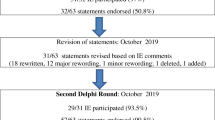Abstract
Background
The term syringomyelia describes many pathogenetically different disorders, and a variety of attempts to group these based on different criteria have been proposed in the literature. As a consequence a lack of consensus regarding classification and terminology exists. This inconsistency extends to the ICD-10 classification of diseases in regards to syringomyelia (G95.0) and hydromyelia (Q06.4). We propose a new unifying concept for classification that also incorporates diagnostics and treatment.
Methods
The PubMed online database was used to gain a general overview of the existing pathogenetic theories in relation to syringomyelia. Illustrative cases at our department were included and similar cases of the literature were found using the PubMed database. All material was reviewed with main focus on the classification and terminology used.
Results
Despite syringomyelia (G95.0) and hydromyelia (Q06.4) existing as independent ICD-10 entities, we have shown that the use of classifying terminology for fluid-filled cavities in the spinal cord is indiscriminate and inconsistent. Even though a general agreement on the believed pathogenetic mechanism exists, and the general treatment methods are used in accordance with this mechanism, the terminology fails to function as a simple and universal link between theory and treatment.
Conclusions
We propose a new causal concept for an ICD classification with syringomyelia (G95.0) as the only describing terminology, thus abandoning the use of hydromyelia (Q06.4). Syringomyelia is divided into five subgroups according to the associated pathologies. The classification is based on applied diagnostics and serves as a clinical guidance for treatment.



Similar content being viewed by others
References
Di Lorenzo N, Cacciola F (2005) Adult syringomielia. Classification, pathogenesis and therapeutic approaches. J Neurosurg Sci 49:65–72
Klekamp J (2002) The pathophysiology of syringomyelia—historical overview and current concept. Acta Neurochir (Wien) 144:649–664
Williams B (1993) Surgery for hindbrain related syringomyelia. Adv Tech Stand Neurosurg 20:107–164
Gardner WJ, Angel J (1958) The cause of syringomyelia and its surgical treatment. Cleve Clin Q 25:4–8
Kyoshima K, Kuroyanagi T, Oya F, Kamijo Y, El-Noamany H, Kobayashi S (2002) Syringomyelia without hindbrain herniation: tight cisterna magna. Report of four cases and a review of the literature. J Neurosurg 96:239–249
Milhorat TH, Capocelli AL Jr, Anzil AP, Kotzen RM, Milhorat RH (1995) Pathological basis of spinal cord cavitation in syringomyelia: analysis of 105 autopsy cases. J Neurosurg 82:802–812
Williams B (1969) The distending force in the production of “communicating syringomyelia”. Lancet 2:189–193
Oldfield EH, Muraszko K, Shawker TH, Patronas NJ (1994) Pathophysiology of syringomyelia associated with Chiari I malformation of the cerebellar tonsils. Implications for diagnosis and treatment. J Neurosurg 80:3–15
Gardner WJ (1965) Hydrodynamic mechanism of syringomyelia: its relationship to Myelocele. J Neurol Neurosurg Psychiatry 28:247–259
Williams B (1986) Progress in syringomyelia. Neurol Res 8:130–145
du Boulay G, Shah SH, Currie JC, Logue V (1974) The mechanism of hydromyelia in Chiari type 1 malformations. Br J Radiol 47:579–587
Heiss JD, Patronas N, DeVroom HL, Shawker T, Ennis R, Kammerer W, Eidsath A, Talbot T, Morris J, Eskioglu E, Oldfield EH (1999) Elucidating the pathophysiology of syringomyelia. J Neurosurg 91:553–562
Ball MJ, Dayan AD (1972) Pathogenesis of syringomyelia. Lancet 2:799–801
Koyanagi I, Houkin K (2010) Pathogenesis of syringomyelia associated with Chiari type 1 malformation: review of evidences and proposal of a new hypothesis. Neurosurg Rev 33:271–284, discussion 284–275
Levine DN (2004) The pathogenesis of syringomyelia associated with lesions at the foramen magnum: a critical review of existing theories and proposal of a new hypothesis. J Neurol Sci 220:3–21
McLone DG (2000) Hydromyelia in a child with chiari II. Pediatr Neurosurg 32:328
Mohanty A, Suman R, Shankar SR, Satish S, Praharaj SS (2005) Endoscopic third ventriculostomy in the management of Chiari I malformation and syringomyelia associated with hydrocephalus. Clin Neurol Neurosurg 108:87–92
Lucchetta M, Cagnin A, Calderone M, Manara R, Rotilio A, Briani C (2009) Syringomyelia associated with Chiari I malformation. Neurol Sci 30:525–526
Marin SA, Skinner CR, Da Silva VF (2010) Posterior fossa arachnoid cyst associated with Chiari I and syringomyelia. Can J Neurol Sci 37:273–275
Hammond CJ, Chitnavis B, Penny CC, Strong AJ (2002) Dandy-Walker complex and syringomyelia in an adult: case report and discussion. Neurosurgery 50:191–194
Richter EO, Pincus DW (2006) Development of syringohydromyelia associated with Dandy-Walker malformation: treatment with cystoperitoneal shunt placement. Case report. J Neurosurg 104:206–209
Erkan K, Unal F, Kiris T (1999) Terminal syringomyelia in association with the tethered cord syndrome. Neurosurgery 45:1351–1359, discussion 1359–1360
Özek MM, Cinalli G, Maixner WJ (2008) Spina bifida: management and outcome. Springer Milan, New York, pp 487–513
Roser F, Ebner FH, Sixt C, Hagen JM, Tatagiba MS (2010) Defining the line between hydromyelia and syringomyelia. A differentiation is possible based on electrophysiological and magnetic resonance imaging studies. Acta Neurochir (Wien) 152:213–219, discussion 219
Conflicts of interest
None.
Author information
Authors and Affiliations
Corresponding author
Rights and permissions
About this article
Cite this article
Blegvad, C., Grotenhuis, J.A. & Juhler, M. Syringomyelia: a practical, clinical concept for classification. Acta Neurochir 156, 2127–2138 (2014). https://doi.org/10.1007/s00701-014-2229-z
Received:
Accepted:
Published:
Issue Date:
DOI: https://doi.org/10.1007/s00701-014-2229-z




